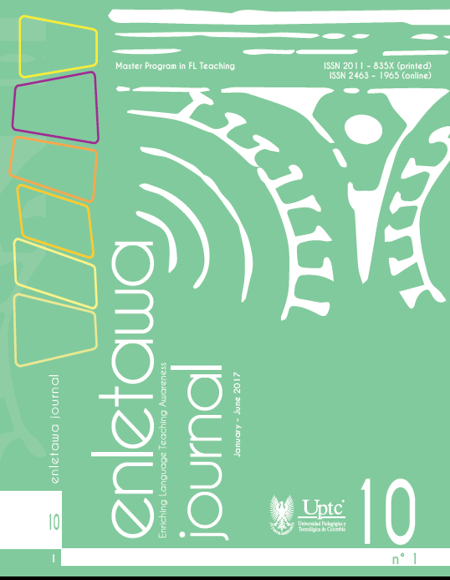Análisis Crítico de la Publicidad: Fortaleciendo la Construcción de Identidad en Clases de Inglés como Lengua Extranjera

Resumen
La literacidad crítica de medios es una competencia que promueve el análisis de los mensajes y estrategias utilizados por los medios de comunicación a través de la mejora e implementación de habilidades críticas. De esta manera, este reporte de investigación describe lo que un proceso de análisis crítico de anuncios publicitarios reveló acerca del proceso de construcción de identidad de veintiún estudiantes de grado décimo, en una institución privada localizada en Duitama (Boyacá – Colombia). La implementación de ocho talleres basados en tareas guió a los estudiantes hacia la reflexión sobre el rol de la publicidad en su contexto y cómo esta se relaciona con su proceso de construcción de identidad. Como resultado, las actividades desarrolladas durante los talleres ayudaron a los estudiantes a comprender el rol de la publicidad en su vida diaria.
Palabras clave
Literacidad crítica de medios, habilidades críticas, anuncios publicitarios, construcción de identidad
Citas
Aguirre, I. (2004). Exploring the critical thinking skills of analysis and evaluation in 9th graders through the use of authentic materials. HOW, a Colombia Journal for English Teachers, 11, 9 – 23.
Alcantud, M. (2011). Manipulation of teenagers through advertising: a critical discourse approach. Revista de Lingüística y Lenguas Aplicadas. 20 – 37.
Böhm, A. (2014). Theoretical Coding: Text Analysis in Grounded Theory. A companion to Qualitative Research. London: SAGE publications
Boyce, C. and Neale, P. (2006). Conducting In-Depth Interviews: A Guide for Designing and Conducting In-Depth Interviews for Evaluation Input. Watertown, Massachusetts. USA: Path Finder International.
Burleson, M. (2010). Mass Media’s Relationship with Adolescents‘ Values and Behaviors: A Theory of Mediated Valueflection. USA: Georgia State University.
Dave, S. (2002). Identity Formation and Difference in Mass Media. In Journalism and Mass Communication (pp. 247261). University of Wisconsin – Madison.
Dörnyei, Z. (2007). Research Methods in Applied Linguistics. New York: Oxford University Press.
Facione, P. (2015). Critical Thinking: What It Is and Why It Counts. Measured Reasons and the California Academic Press, Millbrae, CA.
Fearon, J. (1999). What is Identity (As We Now Use the Word)? Department of Political Science. Stanford University.
Frolova, S. (2014). The Role of Advertising in Promoting a Product. Centria University of Applied Sciences.
Gainer, J. (2010). Critical Media Literacy in Middle School: Exploring the Politics of Representation. Journal of Adolescent and Adult Literacy. International Reading Association. 363 – 373.
Huitt, W. (1998). Critical thinking: An overview. Educational Psychology Interactive. Valdosta, GA: Valdosta State University. http://www.edpsycinteractive. org/topics/cogsys/critthnk.html
James, A. (2014). Qualitative Data Collection. Sage Publications. Walden University, USA. http://www.sagepub.com/sites/ default/files/upm-binaries/15565_ Chapter_4.pdf
Kenechikwu, S. A., Asemah, E., and Edegoh, L. (2013). Behind Advertising: The Language of Persuasion. International journal of Asian Social Science, 3 (4), 951-959.
Mack, N., Woodsong, C., Macqueen, K., Guest, G., and Namey, E. (2005). Qualitative Research methods: A Data Collectors’ Field Guide. North Carolina, USA: Family Health International.
National Association for Media Literacy Education. (2007). Core Principles of Media Literacy Education. Retrieved From: http://namle.net/publictions/ core-principles/
Nunan, D. (2004). Task-Based Language Teaching. Cambridge: Cambridge University Press.
Paul, R. and Elder, L. (2006). The Miniature guide to Critical Thinking, Concepts and Tools. Foundation for Critical Thinking, 4th edition. Retrieved from: www.criticalthinking.org
Richards, J., and Farrell, T. (2005). Professional Development for Language Teachers, Strategies for Teacher learning. New York: Cambridge University Press.